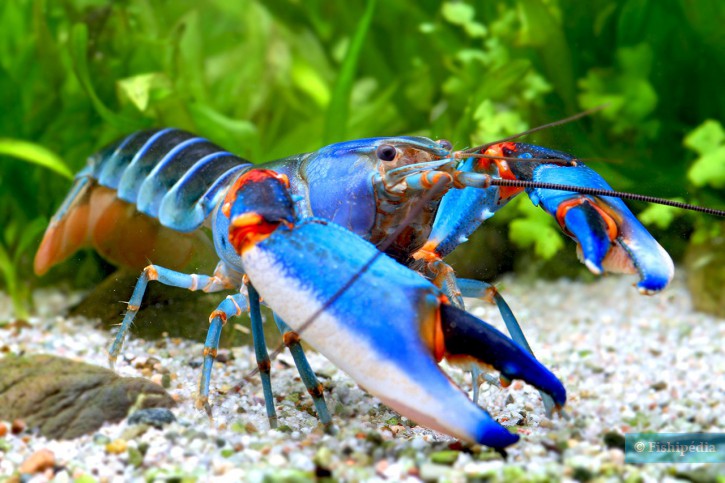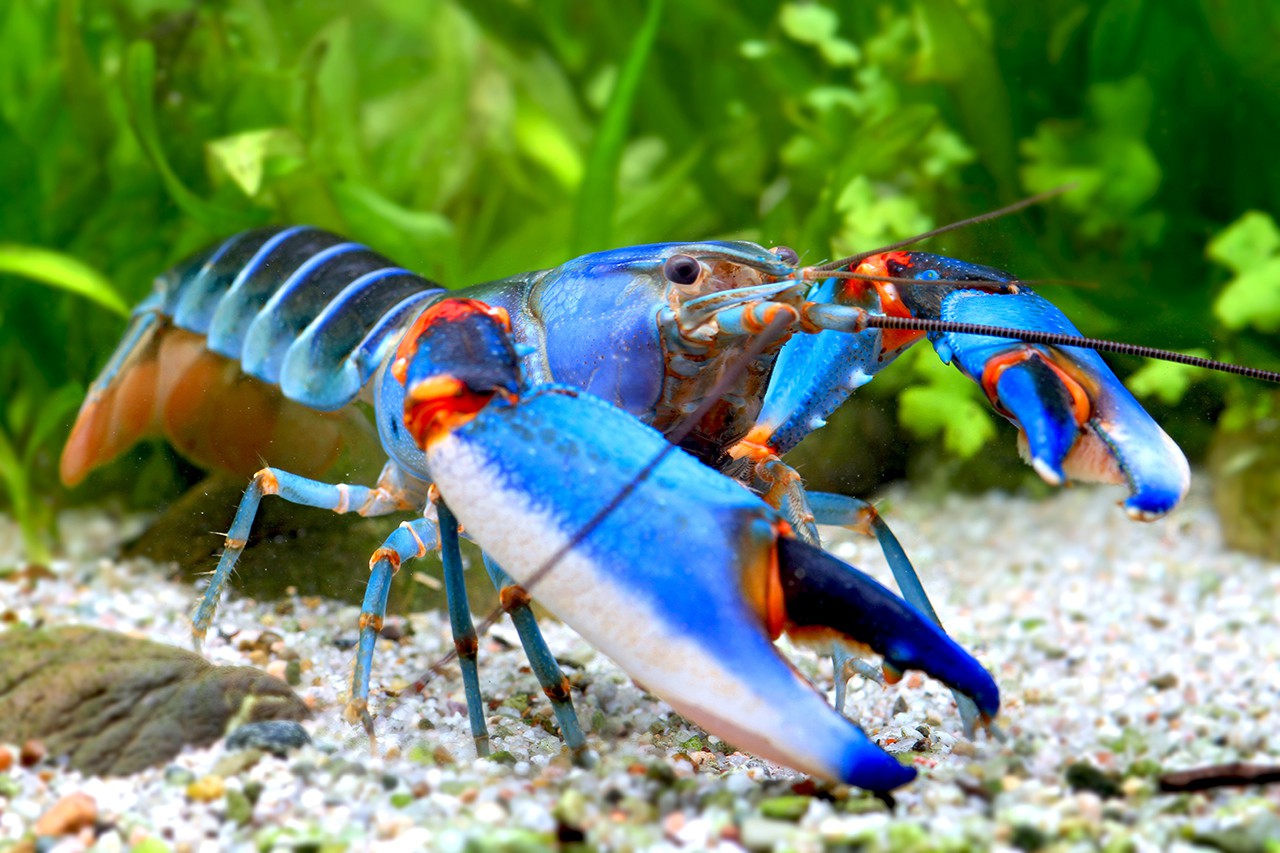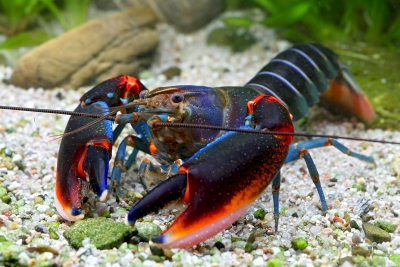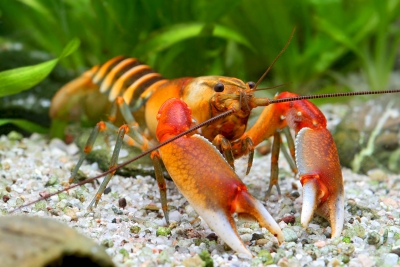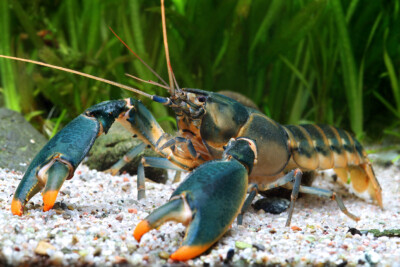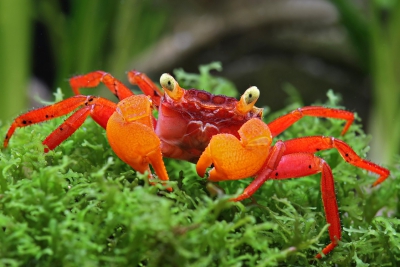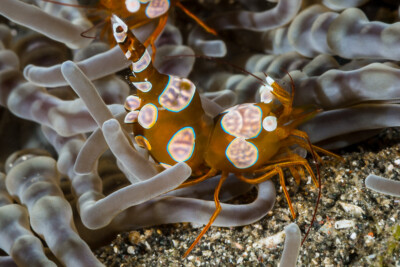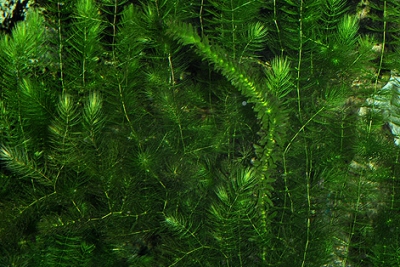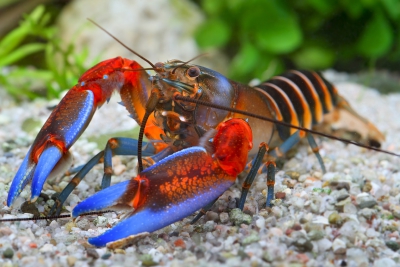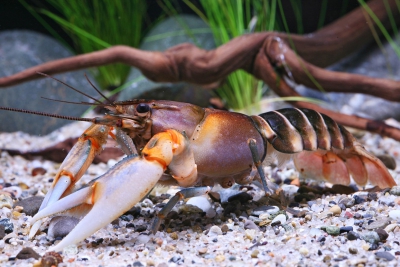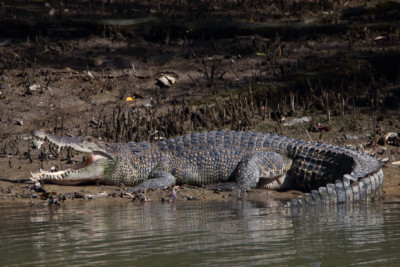Introduction
is a variety of crustacea from selections from Cherax peknyi.
This sheet is currently being prepared. The texts currently proposed come from our data model or are being drafted. To request priority for this content, you can write to us HERE.
Who is it?
Morphology
-
Type
-
Average size10 cm
-
Maximum size12 cm
-
Type
-
Average size10 cm
-
Maximum size12 cm
How to recognize this crustacea ?
Cherax peknyi blue Kong measures between 10 and 12 cm.
The crayfish has claws on the first three pairs of legs. The first pair always has the largest claws, with the second and third pairs usually consisting of simpler claws. The other pairs of legs end in a spine.
Behaviour & Life cycle
-
Sociabilityliving in small groups
-
territorialYes
-
VenomousNo
-
Way of livingnocturnal
Like all crustaceans, Cherax peknyi blue Kong molts whenever it becomes cramped in its shell. Before the hardening of its new body, it is more vulnerable and spends a good part of its time hidden. This mechanism, very complex, allows the periodic renewal of the exoskeleton and part of the internal skeleton. It is also during the moult that the females become fertile.
Cherax peknyi blue Kong is a crustacea living in small groups naturally found on the bottom. This species is omnivorous . Naturally, it tends to dig into the sand and transform its environment. this crustacea lives mainly at night. Usually, it leaves its hiding place and starts to be active once it gets dark.
Although slightly territorial, Cherax peknyi blue Kong is a rather peaceful animal that generally behaves in a peaceful manner with other species.
Cherax peknyi blue Kong has a tendency to dig the ground and bury itself in caves to take refuge.
Reproduction
Like crabs, females incubate numerous eggs under their abdomen. It is an exclusively freshwater species, the whole reproduction process takes place in fresh water. This species follows a mode of reproduction called "direct development". After several weeks of incubation, the female gives birth to fully formed juveniles ready to fend for themselves.
Harmless species
This species does not represent any particular threats to humans when encountered in its natural environment.
Origin and distribution
Geographic distribution & Conservation
This species is a "domestic" animal resulting from selection. It has no natural range.Conservation status of populations (IUCN)
What is its habitat?
Captive breeding species
Main recommendations for fishkeeping
Deontology
In order to preserve wildlife, if you acquire this animal, it must not be released into the wild. See also, the Fishipedia charter.
Fishipedia supports the practice of responsible and environmentally friendly aquarium keeping. We encourage maintenance if it is motivated by a desire to understand the biological functioning of living things and if it is done with respect for animal life.
We believe that aquaristics is an opening to the discovery of aquatic environments, especially freshwater, and that this knowledge is necessary to better protect and respect these environments. Logically, we refute the compulsive purchase of animals that would not find a sufficient and / or adapted place in the host aquarium.
Our recommendations
-
Min volume160 liters
-
Population min2
-
Temperature18 - 29 °C
-
pH (acidity)5 - 8
Characteristics
-
Type of maintenanceAquarium
-
Maintenance difficultyeasy
-
Availabilityrare
-
Behaviourpeaceful
-
Robustnessrobust
-
Environmentfresh water
-
Breedingfresh water
Recommended equipment from our partners
-
Aquarium
-
Filtration
General reminders
It is strongly advised to read the complete dedicated file and to get information on the feedbacks of maintenance of the envisaged animal, this to avoid any potential conflict whose end result is generally the death of the individual (or the other inhabitants). It is important not to overload your aquarium to limit pollution. This will make maintenance easier.
In nature, animals are subject to weather conditions and live in waters with variable characteristics. The recommendations offered by our team for aquarium maintenance are a guidance and cannot be assimilated to scientific datas.
General reminder on maintenance datas
Le démarrage d'un aquarium est une partie primordiale pour l'équilibre et le bien-être des poissons. Lorsque l'on met en eau un aquarium, l'eau passe naturellement par un cycle biologique : le cycle de l'azote. Celui-ci dure environ trois semaines. Tous les 2 jours, nous vous conseillons de tester votre eau jusqu'à ce que le taux de nitrite soit à zéro pendant plusieurs jours d'affilée.
Pour accélérer ce cycle, vous pouvez utiliser un activateur de bactéries comme JBL Denitrol. Cette solution riche en bactéries vivantes et enzymes permet une mise en place rapide du cycle de l'azote. Les poissons peuvent alors être introduits plus rapidement.
Il est important de tester l'eau de son aquarium régulièrement pour maintenir un environnement sain pour les poissons et les autres habitants. Les tests d'eau permettent de mesurer les niveaux de différents paramètres tels que le pH, la dureté totale, ainsi que les taux de nitrates, de nitrites et d'ammoniaque.
Pour réaliser ces tests, vous pouvez utiliser des produits d'analyse spécialisés tels que JBL ProScan qui permet de réaliser un diagnostic de l'eau directement via un smartphone. Il existe également des coffrets de tests plus classiques de bandelettes, comme JBL PROAQUATEST.
En cas d’usage de l’eau du robinet, vous pouvez utiliser un conditionneur d’eau de type Biotopol de JBL pour éliminer les substances nocives comme le chlore, le cuivre, le plomb et le zinc. Une eau trop dure ou trop calcaire peut être inadaptée à de nombreuses espèces tropicales d’eau douce. Si nécessaire, vous pouvez la couper avec de l’eau osmosée ou de pluie filtrée afin d’obtenir une dureté plus adaptée aux besoins de vos poissons et de vos plantes. Les conditionneurs d'eau garantissent une meilleure santé aux poissons et une meilleure croissance des plantes.
Chlorine and chloramine are dangerous for the health of animals. Used to disinfect water, these agents are present in significant quantities in tap water. We recommend using an anti-chlorine agent every time you change the water. In addition to chlorine, treatments and medicines sold for aquarium use sometimes contain dangerous heavy metals in high doses.
Specific needs for Cherax peknyi blue Kong
Cherax peknyi blue Kong is a species which lives naturally at a temperature between 18 °C and 29 °C. Nitrate levels should remain below 50mg/L. To keep the water clean and unpolluted, plan on changing 20% to 30% of the water volume each month.
Breeding this species is accessible to any hobbyist. It is recommended to follow some basic rules and to be rigorous to achieve a good maintenance.
This species is very rare in the aquarium trade. Instead, it is maintained by knowledgeable aquarists who own and breed individuals from wild origin strains. If you want to get this species, we advise you to contact specialized clubs. }Specimens from long time breeding are a bit easier to breed but you have to respect the particular water parameters.
Copper is toxic to many invertebrates. Some fertilizers and aquarium foods contain copper sulfate and should be used with caution. Since Cherax peknyi blue Kong are sensitive to copper, we do not recommend using these products in any form.
Precautions to take with crayfish
By nature, the crayfish has the ability to adapt its gills to breathe in the water, but also outside. This allows it to get out of the water when it lacks food or to escape from predators.
It is also an outstanding climber, it uses this skill to take refuge under woods, rocks or in crevices in its environment. In aquarium, by instinct, it will seek by all the means to leave the tank. Every pipe or hole will be a potential means of escape. To avoid an exit that could be fatal to it, it is necessary to plug all holes in the aquarium.
If by accident it manages to get out of the aquarium, it will be able to survive for a while and adapt its breathing. If you capture it, it is crucial to let it get reaccustomed to the water gradually, for example by putting it on a surface with two land/water areas. Putting it back in the water immediately will result in an irreversible drowning.
Cohabitation & Environment
Being a living in small groups crustacea, it is advisable to install at least 2 individuals in an aquarium of 160 liters minimum. The maintenance in groups allows to observe its natural behavior within the aquarium.
Fearful by nature, it is advised not to let Cherax peknyi blue Kong cohabit with large territorial species or with too aggressive fish. It can easily evolve with territorial neighbors with a peaceful temperament or with non-territorial species.
Be careful to plan an adequate space for each territorial species. Each species should have a surface and a decor allowing it to juxtapose its territory with that of its neighbors.
However, being opportunistic, this species should not cohabit with crustaceans or fish of similar or smaller size because they would in fact become potential prey. Sick species, territorial or sharing the same life zone as this crustacean are the subjects most at risk.
Due to their fragile state during moulting, all crustaceans need an environment provided with hiding places (roots, pebbles, leaves, plants, etc.) to shelter in case of danger. It spends part of its time in burrows. It is important to provide a substantial thickness of substrate so that it can build his refuge.
The species enjoys a particularly vegetation-rich environment. The addition of plants will provide many useful hiding places for resting. These areas are also conducive to possible breeding in the aquarium.
Acid Water Maintenance
Cherax peknyi blue Kong living naturally in acidic water, generally in "black" or "sieved" water, the implementation of a filtration on peat is ideal for its balance. Adding decaying leaves and alder fruit can significantly improve living conditions by naturally increasing acidity of some water.Tips for feeding
Cherax peknyi blue Kong is omnivorous.
Feed animals in moderation to maintain good water quality. Meals should be eaten within 2–3 minutes, served in several small portions rather than a single large ration.
Uneaten food quickly decomposes, releasing ammonia, nitrites, and nitrates, which disturb the aquarium’s biological balance.
Make sure each species can access food properly, slower or bottom-dwelling individuals may require targeted feeding.Reproduction protocol
-
Maintenance difficultymoderate
-
egg-laying protectionNo
Reproduction of this species in an aquarium is considered moderate.
Reproduction of this species is feasible in captivity, with the entire process taking place in fresh water. If the water conditions are met, the females will give birth to fully formed larvae that are ready to fend for themselves at birth.
Hybridization risks
In general, it is advised not to mix several species of the same genus or different varieties of the same species, to avoid the risks of hybridization.
These animals might interest you
These plants might interest you
Plants play a crucial role in aquariums, both for their ability to filter water by absorbing excess nutrients and for their aesthetic contribution. They provide fish with natural hiding places, can serve as breeding sites, and generally help maintain the overall balance and optimal conditions of the aquarium. The selection presented here includes species from the same regions as the species described on this page, although they do not necessarily come from its exact natural biotope.
To go further
Sources & Contributions
Participation & Validation
The Fishipedia team and specialist contributors are committed to providing high-quality content. However, although the information comes from scientific sources or testimonials from specialists, the cards may contain inaccuracies.
Translation
Translation done with the valuable contribution of our translators, who make this information available to a wider audience. We sincerely thank them for their commitment.
Scientific partners
Same genus
Species of the same biotope
